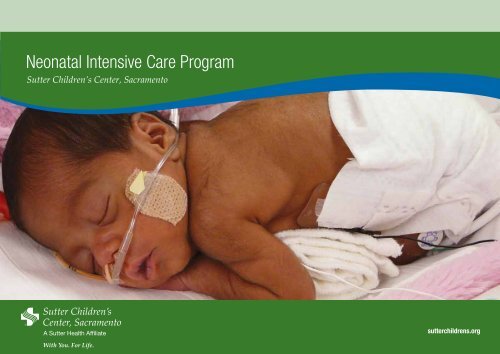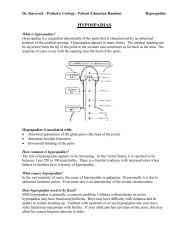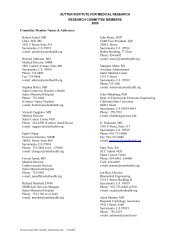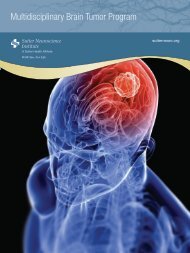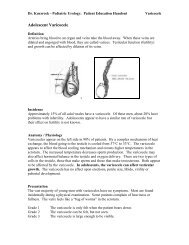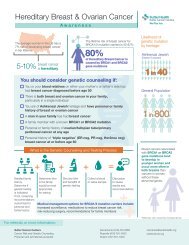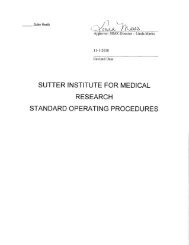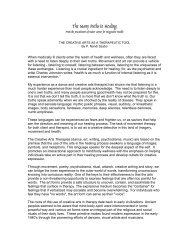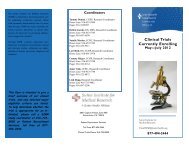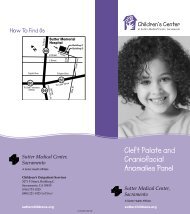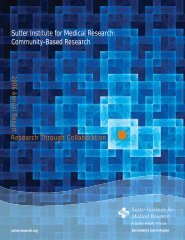Neonatal Intensive Care Program - Sutter Health Sacramento Sierra ...
Neonatal Intensive Care Program - Sutter Health Sacramento Sierra ...
Neonatal Intensive Care Program - Sutter Health Sacramento Sierra ...
Create successful ePaper yourself
Turn your PDF publications into a flip-book with our unique Google optimized e-Paper software.
1<br />
<strong>Neonatal</strong> <strong>Intensive</strong> <strong>Care</strong> <strong>Program</strong><br />
<strong>Sutter</strong> Children’s Center, <strong>Sacramento</strong><br />
sutterchildrens.org
2<br />
Caring for Infants<br />
NICU Hotline<br />
(916) 733-1060<br />
(888) 510-1002<br />
Doctors who call the NICU<br />
speak directly with an on-site<br />
neonatologist—any time of the<br />
day or night, 365 days a year.<br />
The <strong>Neonatal</strong> <strong>Intensive</strong> <strong>Care</strong> <strong>Program</strong> with units (NICU) located at <strong>Sutter</strong> Memorial Hospital, on the <strong>Sutter</strong><br />
Medical Center, <strong>Sacramento</strong> Campus, and <strong>Sutter</strong> Roseville Medical Center provides immediate, advanced<br />
and lifesaving care to infants born prematurely or who need special medical attention. Opened in 1974,<br />
the NICU has grown to become Northern California’s largest and most advanced care center, serving<br />
doctors and families from more than 48 hospitals across 23 counties.<br />
Supporting Families<br />
Family-centered care is a hallmark of our approach. We welcome parents in the NICU and consider them<br />
important members of their baby’s care team who play critical roles in deciding the course of treatment.<br />
Building <strong>Health</strong>y Futures<br />
While we attend to each infant’s immediate medical needs, we consider the NICU a place babies pass<br />
through on the way to happy, healthy childhoods. Our team of support specialists, Developmental<br />
Follow-Up Clinic staff and parent support groups extend care beyond our walls and well into the future.
3<br />
From Our Leadership<br />
The birth of a child is one of life’s most joyful events. But that joy turns quickly to fear when<br />
a child comes too soon, weighs too little, suffers from a serious medical condition or becomes<br />
critically ill. In difficult times, we’re proud that our <strong>Neonatal</strong> <strong>Intensive</strong> <strong>Care</strong> Unit serves as a<br />
lifeline for newborns’ around-the-clock medical care and parents’ continuing emotional support.<br />
As the region’s largest Level III tertiary care NICU, we deliver advanced treatment for all neonatal<br />
conditions—and have for almost 40 years. Our board-certified neonatologists are experts in the<br />
fight for newborn survival. Together, they bring several decades of experience to each infant’s<br />
care. Their expertise combined with the skill of our exceptional nursing staff, more than six dozen<br />
neonatal and pediatric subspecialists and a highly trained support staff provides immeasurable<br />
benefit to our tiny patients and their families.<br />
In this booklet, we present information on our NICU capabilities, along with comparative<br />
outcomes data that support our belief that our NICU teams offer struggling infants an excellent<br />
start on the path to strong and healthy futures.<br />
Andrew W. Wertz, M.D., NICU Medical Director<br />
Andrew W. Wertz, M.D.<br />
Medical Director<br />
<strong>Sacramento</strong> <strong>Neonatal</strong> <strong>Intensive</strong> <strong>Care</strong> Unit<br />
Gustavo Sosa, M.D.<br />
Medical Director<br />
Roseville <strong>Neonatal</strong> <strong>Intensive</strong> <strong>Care</strong> Unit<br />
Table of Contents<br />
4 <strong>Program</strong> Overview<br />
6 Unit Overviews<br />
8 Referrals and Transport<br />
10 Our Team<br />
12 Capabilities<br />
14 Outcomes<br />
16 Family-Centered <strong>Care</strong><br />
17 Looking Forward<br />
18 <strong>Neonatal</strong> Physicians
4<br />
Overview/General Highlights<br />
Our <strong>Program</strong><br />
Approved as a Level III NICU by the California<br />
Children’s Services (CCS), the NICU cares for<br />
multiples, premature and low-birth-weight<br />
babies, infants born with congenital anomalies,<br />
and critically ill newborns.<br />
Comprehensive, Collaborative <strong>Care</strong><br />
Each year, the NICU ushers more than a thousand<br />
infants through its 55-bed unit in <strong>Sacramento</strong> and<br />
16-bed unit in Roseville. Though geographically<br />
separate, the <strong>Sacramento</strong> and Roseville units operate<br />
collaboratively as part of the advanced medical<br />
services available through <strong>Sutter</strong> Women’s Services<br />
and <strong>Sutter</strong> Children’s Center, <strong>Sacramento</strong>.<br />
Nationally Recognized<br />
A children’s “hospital within a hospital,” <strong>Sutter</strong><br />
Children’s Center, <strong>Sacramento</strong> is nationally recognized<br />
as a center for excellence by the National Association<br />
of Children’s Hospitals and Related Institutions<br />
(NACHRI). In addition, <strong>Sutter</strong> is the only nonuniversity<br />
facility in Northern California granted<br />
associate membership with the California Children’s<br />
Hospital Association (CCHA).<br />
Admissions<br />
2009 2010<br />
<strong>Sacramento</strong> NICU .................................................1,118. ..................1,059<br />
Roseville NICU ............................................................373. ......................347<br />
2009 Survival By Gestational Age<br />
2009 length of stay<br />
days<br />
100% 150<br />
80%<br />
60%<br />
40%<br />
20%<br />
0% 0<br />
Services<br />
5<br />
Complete Continuum of <strong>Care</strong><br />
<strong>Care</strong> for NICU infants often begins before birth and extends well into childhood. This care continuum<br />
ensures that each infant admitted to the NICU receives treatment at the earliest possible moment<br />
and the ongoing support needed to achieve the highest level of health.<br />
Preparing for Birth<br />
Many infants come to the NICU through the High-Risk<br />
Maternity <strong>Program</strong> of <strong>Sutter</strong> Women’s Services and<br />
personal consultations with our perinatal/neonatal<br />
specialists. Because of the need for immediate medical<br />
treatment, doctors encourage mothers to deliver in the<br />
high-risk delivery room close to the NICU. When<br />
on-site delivery is not possible, our transport team<br />
can attend local hospital births to provide care before<br />
transporting the infant to the NICU.<br />
High-Tech, High-Touch <strong>Care</strong><br />
Fragile infants need the right combination of medically<br />
advanced care and focused individual attention.<br />
Within our NICU, they receive both in ample measure.<br />
We offer the latest medical treatments and technology<br />
proven to improve outcomes, along with one-to-one,<br />
-two or -three nursing ratios, depending on the infant’s<br />
level of need. We care for our most critical infants<br />
at the <strong>Sacramento</strong> NICU, where a board-certified<br />
neonatologist remains on site 24 hours a day.<br />
Advanced care therapies include:<br />
• Extracorporeal membrane oxygenation (ECMO)<br />
• High-frequency ventilation<br />
• Bubble CPAP<br />
• Inhaled nitric oxide therapy<br />
• Body cooling, also called therapeutic hypothermia<br />
or mild systemic hypothermia (MSH)<br />
Looking Toward Home and Beyond<br />
Infants who start life in the NICU undergo comprehensive<br />
testing and evaluations to determine any<br />
additional medical care required. Child Life Specialists<br />
and Social Workers work with families to help them<br />
prepare for the transition to home and discharge<br />
planners help parents determine next steps in care.<br />
Parents of children at risk for developmental delays<br />
can take part in our Developmental Follow-Up Clinic,<br />
where an interdisciplinary team monitors each child’s<br />
progress and provides information, support and<br />
referrals to community programs, agencies and<br />
consultants, as needed.
6<br />
Unit Overviews<br />
One NICU, Two Locations<br />
Our <strong>Sacramento</strong> and Roseville NICUs operate as a single unit, providing many similar services. While both<br />
are Level III NICUs, the <strong>Sacramento</strong> NICU cares for infants in the most critical need. Served by the same<br />
board-certified neonatologists, the NICUs operate collaboratively to ensure infants receive the care needed<br />
to prosper. Both NICUs welcome parents and encourage them to take an active role in their baby’s care<br />
and treatment decisions. In addition to standard care areas, the NICUs each offer a family sleep room that<br />
allows parents to stay overnight with their babies before taking them home for the first time.<br />
<strong>Sutter</strong> Medical Center, <strong>Sacramento</strong><br />
In operation since 1974, the 55-bed <strong>Sacramento</strong> NICU<br />
offers around-the-clock, on-site care by one of our nine<br />
board-certified neonatologists and a highly trained and<br />
experienced nursing staff. Referring physicians who<br />
call the NICU speak directly to a neonatologist—any<br />
time of the day or night.<br />
The NICU was the first in Northern California to offer<br />
extracorporeal membrane oxygenation therapy to<br />
infants and remains on the leading edge of neonatal<br />
treatment and technology advances. Babies enter the<br />
NICU after mothers give birth in the nearby high-risk<br />
maternity suite, Family Birth Center or through referral<br />
and transport by our <strong>Sutter</strong> NICU Transport Team.
7<br />
Gustavo Sosa, M.D., NICU Medical Director<br />
<strong>Sutter</strong> Roseville Medical Center<br />
Opened in 2008 as an extension of the <strong>Sacramento</strong><br />
NICU, the 16-bed unit offers families in Placer County<br />
and surrounding areas the convenience of care closer<br />
to home. Designed with active input from doctors,<br />
nurses, clinical staff and parents, the Roseville NICU<br />
boasts many family-friendly features, including<br />
warm, spacious design for every room and four<br />
private rooms, the region’s only private rooms for<br />
NICU patients. Babies come to the NICU through the<br />
adjacent Family Birth Center or through our <strong>Sutter</strong><br />
NICU Transport Team. The Roseville NICU offers an<br />
on-site helipad, enabling babies referred from outlying<br />
areas to arrive by ambulance or helicopter.<br />
<strong>Neonatal</strong> <strong>Intensive</strong> <strong>Care</strong> <strong>Program</strong> Services:<br />
• Direct telephone consultations<br />
for physicians, 24 hours a day<br />
• High-Risk Pregnancy <strong>Program</strong>,<br />
including fetal diagnostics<br />
• High-risk delivery suite<br />
with on-site obstetric anesthesiologists<br />
and neonatologists<br />
24 hours a day<br />
• <strong>Sutter</strong> NICU Transport Team<br />
• Extracorporeal membrane<br />
oxygenation (ECMO)*<br />
• High-frequency ventilation<br />
• Bubble CPAP<br />
• Inhaled nitric oxide therapy<br />
• Body cooling, also called mild<br />
systemic hypothermia (MSH)*<br />
• Pediatric subspecialty services<br />
• Surgical services, including<br />
pediatric cardiovascular<br />
surgery, neurosurgery,<br />
orthopedics, otolaryngology,<br />
laser eye surgery and urology*<br />
• Lactation and infant<br />
feeding support<br />
• Developmental assessment<br />
and therapy<br />
• Diagnostic testing of<br />
breathing, hearing, lung<br />
function, vision and hearing<br />
• Child Life services focusing<br />
on on emotional and<br />
developmental well-being<br />
of infant and the family*<br />
• Discharge planning<br />
*Infant may have to be transferred for higher level services offered only at the <strong>Sacramento</strong> NICU<br />
• Developmental Follow-Up<br />
Clinic<br />
• Ongoing parent support groups
8<br />
Referral and Transport<br />
Referrals & Transportation<br />
It’s always to the baby’s advantage to be born in a<br />
room close to our <strong>Sacramento</strong> or Roseville NICU.<br />
When possible, we arrange for mother’s transport so<br />
that she can deliver her baby near the NICU. Since<br />
it’s not always possible to predict when a baby will<br />
be born prematurely or with medical issues requiring<br />
NICU care, our <strong>Sutter</strong> NICU Transport Team is on call<br />
and ready to be on the road or in the air within 45<br />
minutes to assist at the delivery or provide immediate<br />
transport to the NICU.<br />
Colusa<br />
Yolo<br />
<strong>Sutter</strong><br />
<strong>Sierra</strong><br />
Yuba<br />
Nevada<br />
Placer<br />
El Dorado<br />
<strong>Sacramento</strong><br />
Amador<br />
San<br />
Joaquin<br />
Alpine<br />
Calaveras<br />
Tuolumne<br />
Contacting the NICU<br />
To help referring doctors achieve the fastest transfers<br />
possible, our neonatologists answer physician calls<br />
directly, 24 hours a day. Whether doctors need to<br />
arrange a transfer or simply ask questions about a<br />
pregnancy or delivery, our neonatologists welcome<br />
doctors’ calls and answer each one personally.<br />
<strong>Sutter</strong> NICU Transport Team:<br />
Before, During and After Delivery<br />
We’re proud of the skillful transportation services<br />
our <strong>Sutter</strong> NICU Transport Teams provide more than<br />
250 times each year. The team’s neonatal nurses and<br />
respiratory care practitioners are specially trained<br />
in managing airways and stabilizing critically ill<br />
and premature infants during transport. Working in<br />
partnership with CALSTAR for helicopter and fixedwing<br />
aircraft transport and ambulance teams for<br />
ground transfers, team members transport newborns<br />
in special incubators equipped with high-frequency<br />
ventilation, conventional ventilation and nitric oxide<br />
delivery equipment. Services our transport team can<br />
provide include:<br />
On-site delivery support – When labor is too far<br />
along for mothers to be transferred, our NICU<br />
Transport Team can be present in the delivery room to<br />
stabilize the newborn prior to transport.<br />
High-frequency and conventional ventilation –<br />
Depending on the infant’s needs, teams have both<br />
ventilation therapies available to stabilize infants while<br />
en route to the NICU.<br />
Inhaled nitric oxide – Our transport program is one<br />
of only a handful in the country that offers nitric oxide<br />
therapy during transport. This capability is especially<br />
important when infants are not responding well to<br />
other respiratory support methods.<br />
Extracorporeal Membrane Oxygenation (ECMO)<br />
– Our Transport Team is trained and equipped to<br />
transport infants to our NICU for ECMO Therapy when<br />
this high-level procedure is necessary.<br />
Bubble continuous positive airway pressure<br />
(bubble CPAP) – For infants breathing on their own,<br />
bubble CPAP provides breathing support and prevents<br />
lungs from collapsing.<br />
Therapeutic Hypothermia (body cooling) – Body<br />
cooling within the first six hours of life can prevent<br />
complications associated with hypoxic ischemic<br />
encephalopathy. Our Transport Team can provide<br />
body cooling in transport to assure this timeline is met.<br />
The <strong>Sutter</strong> NICU Transport Team is available around<br />
the clock, 365 days a year. Within 45 minutes of a<br />
transport call, a team is on its way, narrowing the<br />
critical gap between a baby’s delivery and arrival at<br />
the NICU.<br />
Stanislaus
9<br />
Contact Us<br />
High-Risk Maternity: (916) 733-7111<br />
NICU: (916) 733-1060 or (888) 510-1002<br />
A perinatology/neonatology specialist is available<br />
24 hours a day, seven days a week to arrange a<br />
transfer or provide emergency consultation.
10<br />
services<br />
Our Team<br />
Behind every infant and family we serve is a corps<br />
of more than 250 medical professionals working in<br />
unison to deliver care to the highest standards.<br />
Neonatologists<br />
Our team is led by nine board-certified neonatologists,<br />
with at least one neonatologist on site in the<br />
<strong>Sacramento</strong> NICU 24 hours a day. Our experienced<br />
neonatologists work collaboratively, bringing each<br />
infant the combined knowledge gained from years<br />
of experience.<br />
Pediatric Specialists and Subspecialists<br />
As part of <strong>Sutter</strong> Children’s Center, our NICU care<br />
teams have easy, immediate access to more than 75<br />
neonatal and pediatric specialists and subspecialists,<br />
including general and specialty pediatric surgeons.<br />
The ability to call in the right medical expert improves<br />
care in the NICU and connects families with medical<br />
care and support after their child goes home.<br />
Nursing Staff<br />
At any hour of the day or night, infants are under the<br />
watchful eyes and skillful hands of at least one of our<br />
more than 150 nurses, many certified in advanced<br />
life support (ALS). Our nurses are the soul of the<br />
NICU and our tiny patients are fortunate to have the<br />
attention of professionals totally dedicated to their<br />
care, whose commitment to working in the NICU<br />
often spans decades.<br />
Support Network<br />
In addition, care teams receive the support of the<br />
NICU Transport Team, neonatal respiratory care<br />
practitioners and Child Life Specialists who help<br />
parents and siblings adjust and cope with their<br />
hospital stay, and provide education and support<br />
so that parents feel confident providing care when<br />
they bring their child home. The team also includes<br />
clinical social workers who help address the dailylife<br />
issues families face and help connect them with<br />
agencies and community resources. The vast care<br />
network also includes lactation consultants, physical<br />
and occupational therapists, pharmacists, and<br />
technicians—all specifically trained to serve infants<br />
with critical needs and their families.<br />
Referring doctors and pediatricians<br />
We understand that our place at the start of a child’s<br />
health care story requires sharing information<br />
with an infant’s previous and future doctors. Our<br />
neonatologists send reports to referring physicians<br />
and are happy to talk to and answer questions from<br />
pediatricians who are providing ongoing care to our<br />
former patients.<br />
Beyond the NICU<br />
<strong>Care</strong> does not end when an infant leaves the<br />
NICU. In addition to ongoing care from pediatric<br />
specialists that often begins in the NICU, children<br />
at risk for developmental delays take part in the<br />
outpatient Developmental Follow-Up Clinic through<br />
Clifford C. Marr, M.D., Pediatric Surgeon<br />
age three. Here they receive the support of a new<br />
interdisciplinary team of medical experts whose<br />
members include:<br />
• Developmental pediatrician<br />
• Pediatric nurse practitioner<br />
• Pediatric physical therapist<br />
• Pediatric occupational therapist<br />
• Clinical psychologist<br />
• Clinical social worker<br />
• Ophthalmologist, as indicated<br />
• Audiologist, as indicated<br />
Children visit the clinic three to four times during the<br />
first three years of life, a much longer period than<br />
most programs offer. The clinic team provides<br />
evaluations and exams, monitors progress and<br />
provides guidance and resources to help parents<br />
promote their child’s development. They also provide<br />
referrals to community programs, agencies and<br />
consultants who offer more information or support<br />
for the family and child’s needs.
11<br />
Teimour Nasirov,<br />
M.D., Pediatric<br />
Cardiovascular<br />
Surgeon<br />
Dedicated NICU<br />
Transport Teams<br />
Direct, immediate<br />
contact with a<br />
NICU neonatologist<br />
More than 75<br />
neonatal and pediatric<br />
subspecialists<br />
High-Risk Pregnancy<br />
<strong>Program</strong>, inpatient,<br />
outpatient and<br />
transport services<br />
<strong>Neonatal</strong> <strong>Intensive</strong> <strong>Care</strong> <strong>Program</strong><br />
Two locations<br />
24/7 on-site, board-certified<br />
neonatologist<br />
Highly trained nurses<br />
Pediatric subspecialists<br />
Childlife services,<br />
lactation support,<br />
clinical social<br />
workers<br />
13 pediatric outpatient clinics<br />
and dozens of pediatric<br />
specialists ensure ongoing care<br />
Long-term followup<br />
care through our<br />
Developmental Clinic
12 Capabilities and <strong>Program</strong>s<br />
Our Services<br />
While infants come to the NICU for a number of<br />
reasons, most are premature and require high-tech<br />
support to complete their development, gain weight<br />
and learn to eat. In our NICU, we provide the full<br />
spectrum of proven technology advances and<br />
treatments that enable them to develop and grow.<br />
In addition to continuous monitoring around the<br />
clock, services we offer include:<br />
Extracorporeal membrane oxygenation (ECMO)<br />
takes over when an infant’s heart and lungs cannot<br />
function properly. The ECMO system pumps blood<br />
from the heart, oxygenates it through an artificial lung<br />
and returns it to the infant’s body. We were the first<br />
NICU in Northern California to pioneer ECMO in the<br />
NICU setting and are still among a select number<br />
who can transport these very critically ill infants for<br />
ECMO therapy.<br />
High-frequency ventilation reduces strain on<br />
immature lungs by keeping them open while<br />
delivering minute amounts of air and oxygen<br />
hundreds of times each minute.<br />
Bubble continuous positive airway pressure<br />
(bubble CPAP) is a method doctors use to keep<br />
infants’ airways open and deliver the appropriate<br />
mix of air and oxygen. Doctors use bubble CPAP<br />
with babies who are breathing on their own to<br />
deliver a slight amount of pressure that keeps the<br />
baby’s lungs from collapsing.<br />
Body cooling, also called therapeutic hypothermia<br />
or mild systemic hypothermia (MSH) helps reduce<br />
neurodevelopment problems that can occur when<br />
babies’ brains are deprived of oxygen during birth.<br />
Immediately after delivery, babies are placed on a<br />
cooling blanket that keeps their body temperatures<br />
slightly below normal, which studies show helps<br />
reduce the extent of brain injuries.<br />
Inhaled nitric oxide may be administered with<br />
ventilation therapy to help blood vessels around the<br />
lungs relax. Studies show that nitric oxide improves<br />
a baby’s ability to absorb oxygen and reduces chronic<br />
lung problems.<br />
Surgery is often the only option when a baby is born<br />
with a malformation that cannot be corrected through<br />
development alone. In those instances, our general and<br />
specialty pediatric surgeons can perform corrective<br />
surgeries to repair anomalies and enable growth.<br />
In addition to general pediatric surgery, surgical<br />
specialties include:<br />
• Pediatric cardiovascular surgery<br />
• Pediatric neurosurgery<br />
• Pediatric orthopedic surgery<br />
• Pediatric otolaryngology (ear, nose and throat) surgery<br />
• Pediatric urological surgery<br />
• Pediatric laser eye surgery<br />
Our comprehensive approach to care helps ensure each<br />
infant that comes through our NICU leaves with the<br />
best chance to achieve optimal health.<br />
“Every single nurse in the NICU not only took wonderful care of Caden, they took care of me and my husband. It’s an<br />
emotional time and the support that they offered was effortless on their part. It was natural because they genuinely care<br />
about each family. And they took us on as individuals and never made us feel our concerns were not valid. I wouldn’t<br />
want to have my baby anywhere else.” Lauren, mother of Caden who was born with breathing complications and needed assistance from CPAP.
13<br />
“I was really impressed that the doctor still put her on my chest and did all the normal steps they<br />
do after birth to help with the bonding. And the staff and doctors supported me in my wish to<br />
exclusively use breast milk for feeding and provided lactation support when she was ready to breastfeed.”<br />
Sara, mother of Elizabeth who was born at 25 weeks weighing exactly 2 pounds.
14<br />
Outcomes<br />
Our Outcomes<br />
To improve quality of care and safety in NICUs<br />
nationwide, the Vermont Oxford Network (VON)<br />
compiles, analyzes and compares outcome data<br />
on about 50,000 infants each year from more than<br />
850 NICUs worldwide. The VON reports provide<br />
benchmarks hospitals can use to improve quality and<br />
provide to families, referring physicians and others.<br />
Admissions between our two locations typically<br />
averages a little more than 1,400 infants each year. In<br />
2009, our <strong>Sacramento</strong> NICU admitted 1,118 infants<br />
and the Roseville NICU, opened in 2008, admitted 373<br />
infants.<br />
Our survival rate for very-low birth weight (VLBW)<br />
infants from the time we began submitting data to<br />
VON in 1994 until 2009 (the latest date VON data is<br />
available) is shown in the chart below.<br />
1994-2009 Infant Survival<br />
VLBW Infants<br />
<strong>Sutter</strong> Children’s<br />
VON average<br />
Higher Is Better<br />
Full-term babies are typically born between 38 and 42<br />
weeks gestation. Many infants we treat are born much<br />
earlier. The chart below shows our infant survival<br />
rates for babies born weighing less than 1,250 grams<br />
(about 2.75 pounds).<br />
2009 Infant Survival<br />
100%<br />
80%<br />
60%<br />
40%<br />
20%<br />
0%<br />
Infant Survival Infants Weighing Less Than 1,250 Grams<br />
<strong>Sutter</strong> Children’s<br />
VON average<br />
By Birth Weight<br />
501-750 751-1000 1001-1250<br />
Higher Is Better<br />
Chronic Lung Disease<br />
One of the most difficult challenges NICUs face is<br />
ensuring infants can breathe on their own following<br />
respiratory therapies that assist or take over breathing<br />
for immature lungs. The respiratory outcomes chart<br />
below shows the average of infants still requiring<br />
oxygen at 36 weeks gestational age by their gestational<br />
age at birth. In this case, lower numbers are better,<br />
as they indicate fewer infants who require oxygen to<br />
breathe at 36 weeks gestational age.<br />
2009 Respiratory outcomes<br />
100%<br />
80%<br />
60%<br />
40%<br />
20%<br />
0%<br />
<strong>Sutter</strong> Children’s<br />
VON average<br />
24-26 Weeks 27-29 Weeks<br />
Oxygen At 36 Weeks GA<br />
Lower Is Better<br />
Vermont Oxford Network 2009 Very Low Birth Weight Database Summary.<br />
Horbar JD, Carpenter JH, editors. Vermont Oxford Network. Burlington,<br />
Vermont. 2010.<br />
84.2%<br />
83.3%
15<br />
Initial Resuscitation<br />
Babies that cannot breathe well enough on their own<br />
need a breathing tube inserted for assistance. Because<br />
this method is more invasive, it has greater risk for<br />
infection. In this case, lower numbers are better.<br />
“We are so impressed with how Chase has grown as a student,<br />
athlete and role model. He is a testament to what you can<br />
accomplish with faith, hard work and dedication.”<br />
Jonathan, father of Chase who was transferred to <strong>Sutter</strong><br />
Memorial Hospital after birth with transposition of the great<br />
vessels and needing immediate cardiac surgery. Chase<br />
didn’t let his health condition slow him down and was an<br />
all-star kicker on his highschool’s football team.<br />
2009 Initial Resuscitation<br />
Delivery Room<br />
ETT Ventilation<br />
100%<br />
80%<br />
60%<br />
40%<br />
20%<br />
0%<br />
24-26 Weeks 27-29 Weeks<br />
<strong>Sutter</strong> Children’s<br />
VON average<br />
Lower Is Better<br />
Vermont Oxford Network 2009 Very Low Birth Weight Database Summary.<br />
Horbar JD, Carpenter JH, editors. Vermont Oxford Network. Burlington,<br />
Vermont. 2010.
16<br />
PATIENT AND Family-Centered <strong>Care</strong><br />
Family-Centered <strong>Care</strong><br />
Our goal for your infant’s stay with us is simple.<br />
We want you to take home a healthy infant you<br />
can care for comfortably and confidently.<br />
While we consider our role vital to your baby’s health,<br />
we recognize that it is fleeting. Long after we become<br />
a faded memory, you will be caring for your child’s<br />
daily needs. That fact is the guiding principle behind<br />
our approach to care.<br />
When your newborn infant is a NICU patient, we<br />
welcome, encourage and do everything possible to<br />
support your involvement. Our nurses include you in<br />
feeding, changing diapers and, of course, holding your<br />
baby. We encourage all mothers to breastfeed and offer<br />
lactation consultants who help make that possible. We<br />
also give you straightforward information and our<br />
professional opinions on the pros and cons of various<br />
treatment options and look to you to help decide the<br />
course of treatment we follow.<br />
Beyond the NICU is a web of support that includes<br />
Child Life Specialists, social workers, discharge<br />
planners, Developmental Follow-Up Clinic, parent<br />
support group and annual reunions.<br />
“If you can’t be the one caring for your baby, the staff at <strong>Sutter</strong> is the next best thing. The NICU team is not only nurses, but teachers too.<br />
They provide what I would describe as a full hands-on education for your baby. Having a premature son was scary because we did not know what<br />
would come next or how to take care of him. The NICU team understands that and teaches parents how to overcome these fears. It is a nurturing<br />
environment that is essential to the baby’s well-being.” Yolanda, patient of the High Risk Maternity Unit and mom of Michael who was born at 28 weeks, 5 days weighing 3 pounds, 4 ounces.
looking forward<br />
17<br />
Looking Forward<br />
In 2012, our <strong>Sacramento</strong> NICU will move into its<br />
new home within the Women’s and Children’s<br />
Center at <strong>Sutter</strong> Medical Center, <strong>Sacramento</strong>.<br />
And yes, we’re excited. The <strong>Sacramento</strong> NICU<br />
is a busy place and we know that while families<br />
are always welcome, they may not always feel<br />
comfortable visiting their infants in our current<br />
space. The new NICU changes all that.<br />
Rendering of the future Women’s and Children’s Center<br />
Just as our nurses and doctors helped design the<br />
new Roseville NICU, which is among the most<br />
parent-friendly NICUs you’ll find, they guided<br />
the design of the new <strong>Sacramento</strong> NICU. Familyfriendly<br />
features include:<br />
• More space and greater privacy for parents<br />
and infants to promote bonding and make<br />
breastfeeding easier<br />
• Sound-deadening materials in the walls and<br />
individualized lighting and sound so that<br />
infants get the restful quiet they need<br />
We’re also grateful to our downtown neighbors for<br />
allowing the new center to include a rooftop heliport.<br />
Helicopter access will speed and simplify transport,<br />
reducing the time between birth and NICU admission<br />
for our fragile patients and helping us bring high-risk<br />
maternity patients to the center for delivery.<br />
The current NICU houses a wonderful staff and all<br />
the technological advances needed to care for infants.<br />
The new NICU will provide a nursery environment<br />
that matches and gives parents and infants a peaceful<br />
place to bond and grow.<br />
(Top) The “one in eleven million” naturally occurring identical<br />
Khamsa quadruplets were born at <strong>Sutter</strong> Memorial in 2002.<br />
(Bottom) Khamsa quadruplets attended the Women’s and<br />
Children’s Center Groundbreaking in 2008.
18<br />
our physicians<br />
<strong>Neonatal</strong> Physicians<br />
The following physicians are part of <strong>Sutter</strong> Children’s Center <strong>Neonatal</strong> <strong>Intensive</strong> <strong>Care</strong><br />
<strong>Program</strong> and are board-certified/fellowship trained in neonatal-perinatal medicine:<br />
Stephen R. Butler, M.D.<br />
Eva Granzow, M.D.<br />
Chiwan Kim, M.D.<br />
Cindy Korte, M.D.<br />
Arthur B. Lyons, M.D.<br />
Erlinda Manalo, M.D.<br />
J. Fernando Rosas<br />
Carrillo, M.D.<br />
Gustavo Sosa, M.D.<br />
Andrew W. Wertz, M.D.
19<br />
“I think everybody needs to know that if your child<br />
ever needs to be in this situation, they couldn’t be<br />
in better hands. It’s a difficult situation, certainly,<br />
but knowing our babies are being tended to by<br />
such wonderful people makes all the difference.”<br />
Danielle, mother of quads born at 27 weeks,<br />
weighing between 1.15 and 2.2 pounds each.
20<br />
A609911P 3/11 3,500<br />
5151 F Street, <strong>Sacramento</strong>, CA 95819<br />
Non-Profit Org.<br />
U.S. Postage<br />
PAID<br />
Permit No.333<br />
<strong>Sacramento</strong>, CA<br />
sutterchildrens.org


